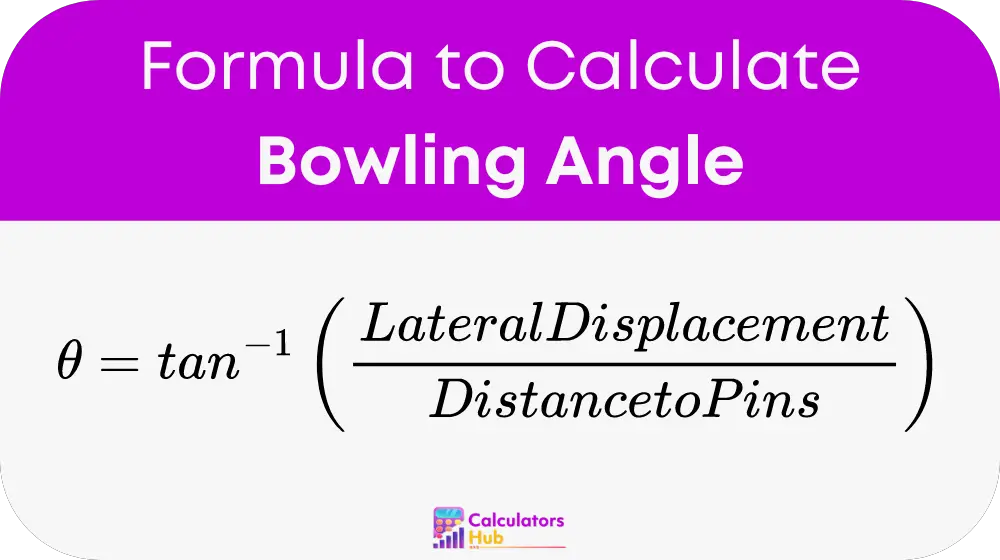The Bowling Angle Calculator helps bowlers, coaches, and enthusiasts determine the exact angle at which a bowling ball travels across the lane toward the pins. Understanding the bowling angle is crucial in improving accuracy, predicting ball movement, and increasing the chances of hitting strikes or spares.
When a bowling ball is released, it often travels straight before hooking (curving) toward the pins due to spin. This hook can cause lateral displacement, and the angle formed between the ball’s path and the target pin can be measured using the Bowling Angle Calculator. The calculator provides an easy way to understand how the ball’s movement across the lane (lateral displacement) affects its approach to the pins.
Formula of Bowling Angle Calculator
The formula to calculate the bowling angle is:

Variables:
- θ: Bowling angle, measured in degrees, indicating the angle formed between the ball’s path and the lane.
- LD: Lateral displacement, the horizontal distance the ball moves across the lane due to hooking or spin (measured in meters or feet).
- DP: Distance to the pins, which is the length of the bowling lane from the release point to the pins (standard distance is 18.29 meters or 60 feet in a regulation lane).
Key Points:
- Lateral Displacement (LD) measures how much the ball shifts horizontally due to its hook. This depends on factors like ball speed, lane oil pattern, and the spin imparted by the bowler.
- Distance to Pins (DP) is fixed for standard bowling lanes, but the formula can accommodate variations if needed for other formats.
- The Bowling Angle (θ) is vital for assessing how the ball’s trajectory changes and how the bowler can adjust to improve accuracy.
Common Terms and Reference Table
Below is a table of common terms and concepts associated with bowling angle calculations, designed to help users better understand the calculator’s purpose and how it applies to improving bowling performance.
| Term | Definition |
|---|---|
| Bowling Angle (θ) | The angle at which the ball approaches the pins, calculated from lateral displacement. |
| Lateral Displacement (LD) | The horizontal movement of the ball across the lane, usually caused by the ball’s hook. |
| Distance to Pins (DP) | The total length of the lane from the bowler’s release point to the pins, typically 60 feet. |
| Hook | The curving movement of the bowling ball, resulting from spin and lane friction. |
| Strike | Knocking down all 10 pins on the first ball. |
| Spare | Knocking down all remaining pins on the second ball after the first throw. |
| Oil Pattern | The pattern of oil applied to the bowling lane, which affects ball speed and hook. |
Example of Bowling Angle Calculator
Let’s go through an example to show how the Bowling Angle Calculator works. Suppose you are bowling and have observed the following data:
- Lateral Displacement (LD): The ball hooks 3 feet across the lane.
- Distance to Pins (DP): The standard bowling lane distance is 60 feet.
Step 1: Apply the Formula
Bowling Angle (θ) = tan⁻¹((Lateral Displacement (LD)) ÷ Distance to Pins (DP))
Substitute the values:
θ = tan⁻¹(3 ÷ 60)
Step 2: Calculate
First, divide the lateral displacement by the distance to the pins:
3 ÷ 60 = 0.05
Now, calculate the inverse tangent (tan⁻¹) of 0.05:
θ ≈ 2.86 degrees
In this case, the bowling angle is approximately 2.86 degrees, meaning the ball approaches the pins at a slight angle due to the hook. Understanding this angle helps the bowler make adjustments to their release or spin to improve accuracy and hit their target.
Most Common FAQs
The bowling angle helps bowlers understand how much the ball hooks and moves across the lane, providing valuable insights into improving accuracy and increasing the likelihood of hitting strikes. By knowing the angle, bowlers can adjust their release, speed, or ball rotation to control the hook and better aim for the pins.
The oil pattern on the bowling lane influences how much the ball hooks. A heavier oil pattern reduces friction, causing less hook, while a lighter oil pattern increases friction, resulting in more hook. Understanding the oil pattern can help bowlers predict how much lateral displacement to expect, affecting the bowling angle.
Yes, a very large bowling angle might cause the ball to miss the pocket or result in a split, while a very small angle might reduce the ball’s impact on the pins. Finding the right angle is key to optimizing strikes and spares. Adjustments in speed, spin, or positioning can help control the bowling angle effectively.